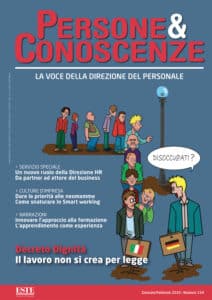
The practice of coaching in the age of stress
1 March 2019
MOTIVATING GIVES ENERGY TO CHANGE
7 March 2019The benefits of emotional intelligence: knowing and managing new skills

In recent years, interest in the topic of emotions is experiencing a moment of strong growth.
In the workplace, we are witnessing a renewed focus on people’s well-being, which inevitably involves listening to emotions.
Recent studies, also accredited by the awarding of Nobel prizes, have highlighted the decisive role of emotions in decision-making processes, and this helps to understand how emotional awareness can contribute to producing better work performance.
For the Human Resources function, it then becomes essential to assess emotional intelligence in the professional sphere.
And unlike in the past, today these issues can be addressed on a scientific basis. We talked about this with Diego Ingrassia, CEO of I&G Management and author of the book Il cuore nella mente (The Heart in the Mind) -a tool that guides the reader in the discovery of emotional-behavioural assessment- and with Marcello Mortillaro, Senior Researcher at the Swiss Center for Affective Sciences, one of the world’s most advanced centres for research on emotions.
It is now more than 20 years that we have been talking about emotional intelligence, but it seems to me that in recent years interest in the subject has grown even further.
Do you also have this impression? .
Diego Ingrassia:It is true, for some years now we have been talking a lot about emotions, often in an imprecise and superficial way.
I think this depends a lot on the way communication has changed.
It is enough to remember how much the massive use of smartphones, a tool that is, after all, only 10 years old, has contributed to forms of communication, such as those on social networks, which are synthetic, instantaneous and based mainly on images, which are by definition in search of a strong emotional impact.
But beyond the media aspect, in recent years we have seen a gradually growing interest on the part of many in the world of work and beyond.
I believe that this is not just linked to a fashion of the moment, but to a deeper need that our society has been manifesting in recent years.
Is it possible to describe this ‘deeper’ need?
D.I.: I think the constant increase in the number of participants in our certification courses is due to the loss we are experiencing in the ‘being’ dimension, supplanted by a frenzy that leads us to focus inordinately on the ‘doing’ dimension.
Our culture has never helped us to deepen our understanding of emotional dynamics, and this is one of the reasons that led us, in 2008, to rely on the studies and theories of the world’s most authoritative scientist in this field: Professor Paul Ekman, with whom we collaborate to make his research usable through methodologies that can also be applied in corporate contexts.
It has always been important to us to deliver training in a practical and experiential manner, but based on scientifically validated models.
This is also the reason why we are here today with Marcello Mortillaro.
The topic of emotions has in fact also stimulated interest from the scientific community… Marcello Mortillaro
Marcello Mortillaro: Yes it has, and it is precisely the focus on the scientific approach that made me decide to collaborate with Diego’s company.
I also think it is important to point out that, in the case of this great interest in emotions, we are dealing with one of the rare cases in which the initial push came precisely from the academic world.
There are several examples we can give, starting with the Nobel Prizes awarded for Behavioural Economics, I am referring to that to Daniel Kahneman in 2002 and, more recently, to Richard Thaler in 2017.
The common aspect of these researches is that they have made people understand the role of the emotional component in economic decisions.
They have effectively opened a breach within an academic discipline that analysed economic thinking from a purely rational perspective.
These scholars have made us realise that reality is very different.
The same thing has also happened in other disciplines in recent years: emotions, long seen as a limitation, have been re-evaluated as resources.
How did the transition from the world of research to civil society take place?
M.M.: There could be many examples here too: I am thinking of what Yale University did in the United States.
A protocol called Ruler has been created: it is a kit that any school can obtain on request, consisting of a set of exercises that teachers can adopt to develop emotional competences with children.
This is something that would never have been done 20 years ago.
A final example is the Disney Pixar film Inside Out, for the making of which leading emotion researchers, including Paul Ekman, worked: it is a product dedicated to entertainment, but with characteristics that allow important lessons to be passed into the collective consciousness.
Can you give me some examples of research indicating the importance of emotional intelligence?
D.I.: An interesting case is that of a study involving almost 600 students at Milan State University: it confirmed how some emotions, which some people call ‘negative’, can instead play a decisive role in our decisions.
Melancholy for example is a mix of emotions that includes sadness and happiness.
Through this research, we have shown that the emotions we feel influence the value we place on things.
In what sense?
D.I.: Companies that are able to generate, through their advertisements, the emotion of sadness, are more likely to sell their products and charge a higher price, this is because, when we are sad, we are triggered by a feeling of loss and are therefore more willing to pay more for what we don’t have and to sell at a lower price what we already own.
In recent years we have also conducted research in sports, following a volleyball team in the women’s Serie A league and discovered which emotions, when effectively managed, can lead a team to a better performance.
Today, together with Marcello, we are collaborating on calibrating the first test that ‘experientially’ assesses the emotional competence of the Italian managerial population.
Is there anything new or important happening in the research on emotions?
M.M.: In the most recent developments in emotion research I see an attempt to go further, to change the paradigm on some important elements.
In the observation of non-verbal behaviour, for example, we used to focus a lot on the face and little on the other aspects, today we are seeing an increasing trend of analyses characterised by a multimodal approach.
Taking face, posture, voice, gestures and words into account simultaneously was something that was not done before, also due to methodological and technological limitations.
This represents a real change: a more holistic view of emotional communication.
The last important aspect to emphasise is a greater focus on questioning the applicability of research from the outset.
Ask yourself from the outset why we are doing this and what it is for.
This pragmatic approach is very important in terms of effectiveness and helps to reduce the time it takes to move from the laboratory to the reality of work organisations.
What research are you currently doing at your centre?
M.M.: First of all, it is important to remember that it is a multidisciplinary research centre, an emanation of the University of Geneva.
It is staffed by researchers from different disciplines: Psychology, Neuroscience, Philosophy, Economics, Sociology active in interdisciplinary research projects.
There are dozens of ongoing research projects, my field of interest being research on emotional competence.
Among the projects I am currently following one aims to try to understand, through the study of non-verbal communication, how the perception of emotions changes within different cultures, with a particular focus on making observations as close to real situations as possible.
I then follow a research project on emotional competences in the nursing profession and a research activity at a major training institute in the service and management professions, which is very interesting because we have the opportunity to follow students over a 10-year period and thus assess, through the test we have created, their emotional competences at the beginning of their studies and after a few years of professional activity undertaken.
What is the attitude of companies towards emotions? What demands do organisations put on you?
D.I.:In the last two to three years, we have witnessed an increase in interest in people’s well-being.
A significant example is the requests geared towards finding effective strategies for stress management.
The interesting aspect we are finding is that making people aware of their emotions helps counteract the mentality – typical of many work environments – that always wants to achieve effective results in a very short time.
Learning to listen to one’s own emotions helps to understand that improvements, even important ones, can be achieved, but they require the right amount of time to develop adequate competence and awareness.
How do you help companies on these issues?
D.I.: Many of the participants in our courses asked me, more and more often, for a tool that could foster awareness of emotions and help people, even those who are not specialists in the subject, to approach models and strategies for managing emotions more confidently.
It is for this reason that I decided to publish a book that condenses the last few years of our group’s work and to which Paul Ekman contributed an interesting preface.
The book is entitled The Heart in the Mind, and the theories I have decided to explore refer to studies and research that have found solid confirmation within the entire scientific community.
The book has the ambition of becoming a working tool, which lends itself to different levels of reading and deepening, a handbook, for all those who wish to delve into emotional-behavioural analysis.
Remaining among the tools, the emotional intelligence assessment test you mentioned, what does it assess and how is it structured?
M.M.: First of all, it is essential to explain some of the peculiar characteristics of the test that differentiate it from others.
It does not measure a personality trait, but evaluates specific competences and, unlike other tests, it is not a self-assessment, but an assessment -this is the second important distinction- during which tasks are assigned, situations that must be answered, which generate more or less correct answers, with respect to criteria based on theoretical aspects and empirical data that we have collected.
The skills we measure with this instrument are: the ability to recognise emotions from non-verbal behaviour; the ability to understand the other person’s emotions and thus be able to tune in to their emotional state; the ability to manage the other person’s emotions; the ability to manage one’s own emotions.
In summary, we can say that during the test we observe these competences and assess how skilfully people use them.
I would also like to add one last element relating to the work done: the situations subject to the test arose through the processing of many interviews made with managers of different companies concerning their experiences in managing professional situations that had generated emotional involvement.
Let us then focus on companies in the professional sphere: what elements can we highlight in this sense?
D.I.: This test was created to assess emotional competence in the professional sphere, hence not personal or clinical.
Our experience has taught us that emotional behaviour can vary significantly in relation to context: probably each of us has known people who behave very differently when observed in private life compared to the work environment.
Talking about these differences also helps me explain the calibration work we are doing on the test to adapt it to the Italian managerial world.
We expect to be ready for distribution as of June 2019.
What is the main importance of this test?
D.I.: In addition to being an extraordinarily effective tool in the field of selection and potential assessment, thanks to its predictive capacity in behavioural areas that are scarcely investigated by other instruments, the test will allow us to make training on emotional competences even more effective, because it can be used as self-diagnosis feedback within courses, but also give us the possibility of assessing the effectiveness of those training courses that are developed over a long period of time, using the test at the beginning and at the end of the course.
I have the impression that, at least in some corporate contexts, there is still a certain mistrust present: a thought that emotions are important, but that the things that really matter are others.
What do you think?
M.M.: It is true that there is still some resistance, but I think it is now very marginal compared to the past, especially among young people, who are more open about these issues, which they define generically as ‘soft skills’.
This is an important step, because they have understood that these qualities – like any other competence – can be learned and trained, and we know that this is exactly the case. Emotional intelligence can be improved over the years through experience, although the best performance is always linked to a combination of competence and experience.
D.I.: Companies want to see results, that’s the problem.
So it is not enough to fascinate people with the subject of emotions, we have to be able to demonstrate how this specific competence improves job performance.
Having solid knowledge, experience, awareness and effective tools at our disposal is crucial.
For too many years, these topics have been approached with tools without a scientific basis and conditioned by an excess of subjectivity: this is one of the most important aspects of our collaboration, it is an important value of which we are proud.



